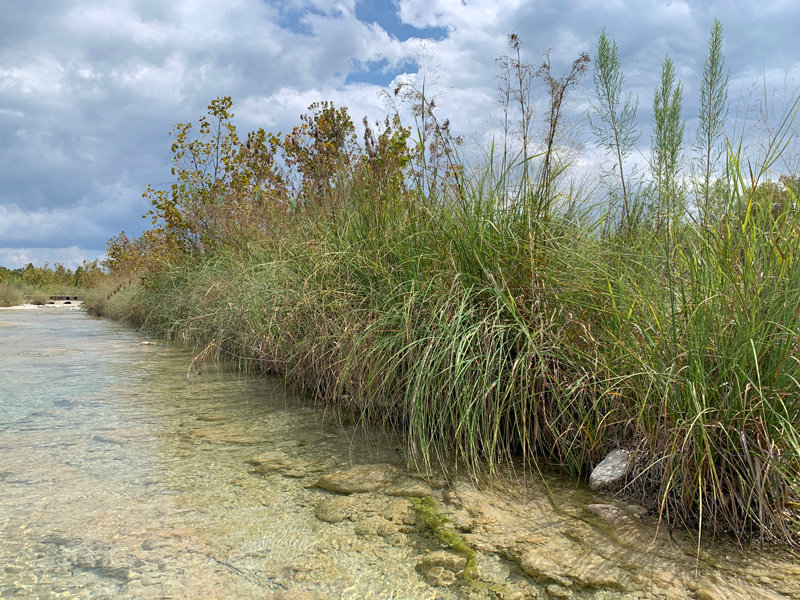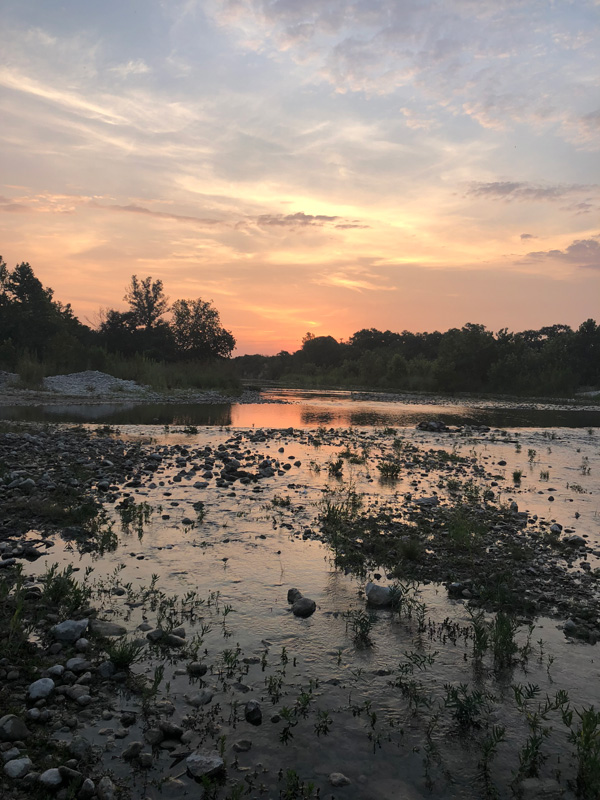The Nueces River is vast, even by Texas standards. It starts high up on the Edwards Plateau.
Sourced by emerald, spring-fed creeks in Edwards and Real Counties, the Nueces River cuts through the rocky Hill Country before pivoting amidst the South Texas Brush Country, onward toward the coastal prairie; it pauses at Lake Corpus Christi, before it ultimately empties into the Gulf of Mexico at Nueces Bay.
Few, if any, know this river better than Sky Lewey. Born in Uvalde, Lewey was raised outside of town on the banks of the Nueces River. “I was swimming before I was walking,” she said.
The river has long supported Hill Country agriculture — cattle, cotton, wool and mohair production — while also providing fishing, hunting, and other recreational opportunities.
One of Lewey’s earliest memories is sitting with her grandfather in a johnboat, peering over the ledge, into the crystal-clear water while he fished the deep holes.
“My family has been ranching along the Nueces for six generations. As a kid, I was always horseback, moving livestock, and whenever we’d have to cross the Nueces, we’d jump off our horses to cool off.”

For more than 20 years, Lewey has worked for the Nueces River Authority, supporting fellow landowners and communities to take care of the land and water that comprise the expansive river basin. And on good days, she’s able to leave her desk and boots behind to step into those cooling, clear waters. “That river has given me my bearings.”
During her time at the Nueces River Authority, Lewey has interacted with thousands of land stewards. She draws from her familial experience living and ranching along the Nueces River as well as decades of experience bringing together researchers and land managers to address emerging problems.
“Everything we do on the land is eventually reflected in a river,” she said. “That’s why it’s so important to think about the whole landscape, how big and little pieces fit together.”
Everything we do on the land is eventually reflected in a river.
– Sky Lewey
Perhaps the most intricate aspect of this riverine patchwork is the intertwining of surface and groundwater. Through its interaction with porous and cracked limestone beneath our feet, the Nueces River Basin is estimated to provide approximately 60 percent of the recharge to the Edwards Aquifer, the primary source of drinking water for the City of San Antonio.
Across the Upper Nueces, researchers have identified stretches of the river that gain flows sourced by springs and underground aquifers, versus alternating reaches that, in fact, lose flows as they seep back under ground, recharging the groundwater. Ongoing studies are assessing how this natural, oscillating pattern shapes the river and aquifers.

When most people think about the health of a river, they look into the channel, focusing narrowly on the water. In a pioneering fashion, Lewey has challenged this natural tendency by cultivating a state-wide appreciation for riparian areas. Often overlooked, misunderstood and mismanaged, riparian areas are the verdant, transitional zones adjacent to a creek, river, or lake.
When characterized with a diversity and abundance of deep-rooted, native plants, riparian areas provide a multitude of benefits, such as greater bank stability, flood mitigation, fish and wildlife habitat, and cleaner water. By hosting ranch workshops, creating riparian field guides, and conducting countless presentations, Lewey has demonstrated that the health of our Hill Country rivers is intrinsically related to the health of these riparian areas.
If there is a particular hindrance, such as a poorly designed stream crossing or low water dam, excessive riparian grazing or mowing, Lewey will encourage landowners to use thoughtful steps to manage that stressor.
Otherwise, she underscores that creeks and rivers love fixing themselves and its often best to let them recover on their own. “Acceptance is the thing — love and accept Hill Country rivers and riparian areas as they, rather than trying to change them to look like somewhere or something else.”
When a healthy river or riparian areas is altered (such as by excessive grazing, mowing, or a large-scale development), the change can alter the balance of how water and sediment are carried downstream.
Over time, rivers recalibrate. Perhaps they may change the slope of their channel by adding a meander to slow down erosive forces. Or, they may cut across a bend when faced with too much deposition of sediment and not enough water.
Lewey has seen this recovery first-hand along her family’s stretch of the Nueces. After vehicles were removed from recreating in the river, the riparian area began to recover. Once bare, cobble bars are now comprised of native shrubs and trees such as sycamore, mulberry, black willow, and buttonbush, along with wildflowers, vines, and deep-rooted native grasses like Switchgrass and Eastern Gamagrass. These riparian plants have stabilized the banks, reducing erosion into the river.
Without the understanding of and appreciation for how Hill Country creeks and rivers function — the dynamic interaction of soil, water, and vegetation — often, Lewey cautions that good intentions and quick fixes can harm these iconic systems. “When it comes to our Hill Country rivers, ‘Doing a little and watching a lot’ is a safe approach.”
She recognizes that this is a challenging message. “We have this innate desire to fix things and it’s really tough to simply appreciate them as they are, especially if they’re different than what we’re accustomed to.” Rather, we should employ management strategies that work with — not against — these natural river and riparian processes.
Essential to maintaining clear, clean rivers is sound land stewardship. “Watch closely, try a few small experiments, and see what works. And if you can watch closely, you’re going to learn a lot and achieve your desired outcomes.”
And there’s another silver lining to Lewey’s philosophy of love, acceptance, and understanding how all the pieces fit together. “If you can appreciate the natural condition and function of the land and river, you’re going to save yourself a lot of work.”


